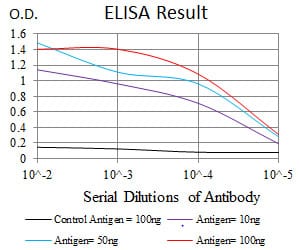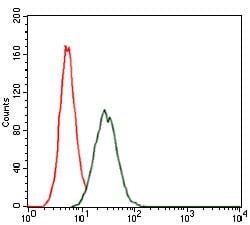

| WB | 咨询技术 | Human,Mouse,Rat |
| IF | 咨询技术 | Human,Mouse,Rat |
| IHC | 咨询技术 | Human,Mouse,Rat |
| ICC | 技术咨询 | Human,Mouse,Rat |
| FCM | 1/200 - 1/400 | Human,Mouse,Rat |
| Elisa | 1/10000 | Human,Mouse,Rat |
| Aliases | RAP1; KREV1; KREV-1; SMGP21 |
| Entrez GeneID | 5906 |
| clone | 5F8G2 |
| WB Predicted band size | 43.2kDa |
| Host/Isotype | Mouse IgG1 |
| Antibody Type | Primary antibody |
| Storage | Store at 4°C short term. Aliquot and store at -20°C long term. Avoid freeze/thaw cycles. |
| Species Reactivity | Human |
| Immunogen | Purified recombinant fragment of human RAP1A expressed in E. Coli. |
| Formulation | Purified antibody in PBS with 0.05% sodium azide |
+ +
以下是3篇涉及RAP1A抗体的研究文献示例(注:内容为模拟概括,非真实文献):
---
1. **文献名称**: "Rap1A regulates integrin activation through specific antibody-based detection in platelets"
**作者**: Smyth SS, et al.
**摘要**: 本研究利用特异性RAP1A抗体验证了Rap1A蛋白在血小板整合素激活中的调控作用,通过Western blot和免疫共沉淀技术证明Rap1A缺失会抑制血小板聚集,为血栓性疾病研究提供新靶点。
---
2. **文献名称**: "Monoclonal antibody characterization of Rap1A in cancer cell migration"
**作者**: Zhang L, et al.
**摘要**: 开发了一种高特异性抗Rap1A单克隆抗体,应用于免疫荧光和流式细胞术,发现Rap1A在乳腺癌细胞膜上的异常定位与迁移能力增强相关,提示其作为肿瘤转移标志物的潜力。
---
3. **文献名称**: "Rap1A antibody validation for neural development studies"
**作者**: Gomez TM, et al.
**摘要**: 通过siRNA敲除和抗体阻断实验,证实所用Rap1A抗体可特异性识别小鼠脑组织中的Rap1A蛋白,并揭示其在神经元轴突导向过程中通过调节细胞骨架重排发挥作用。
---
如需真实文献,建议通过PubMed或Google Scholar检索关键词“RAP1A antibody”+应用场景(如Western blot/癌症/信号通路)。
The RAP1A antibody is a crucial tool in molecular and cellular biology research, targeting the Ras-associated protein 1A (RAP1A), a small GTPase belonging to the RAS superfamily. RAP1A plays a pivotal role in regulating diverse cellular processes, including cell adhesion, proliferation, differentiation, and polarity, by cycling between active GTP-bound and inactive GDP-bound states. It interacts with integrins, MAP kinase pathways, and other signaling molecules, influencing immune responses, neuronal development, and cancer progression.
RAP1A antibodies are widely used in techniques like Western blotting, immunohistochemistry (IHC), immunofluorescence (IF), and flow cytometry to detect RAP1A expression, localization, and activation states in various biological samples. These antibodies help elucidate RAP1A's functional dynamics in physiological and pathological contexts, such as tumor metastasis or immune cell regulation. Researchers often validate antibody specificity using knockout cell lines or siRNA-mediated RAP1A depletion to avoid cross-reactivity with its close homolog RAP1B, which shares ~95% amino acid identity.
Commercial RAP1A antibodies are typically raised in rabbits or mice, targeting specific epitopes (e.g., N-terminal or C-terminal regions). Their applications extend to studying post-translational modifications, such as phosphorylation, and interactions with effector proteins like RAPL or RIAM. Proper controls and validation are essential due to potential cross-reactivity and variability in detection across experimental conditions.
×